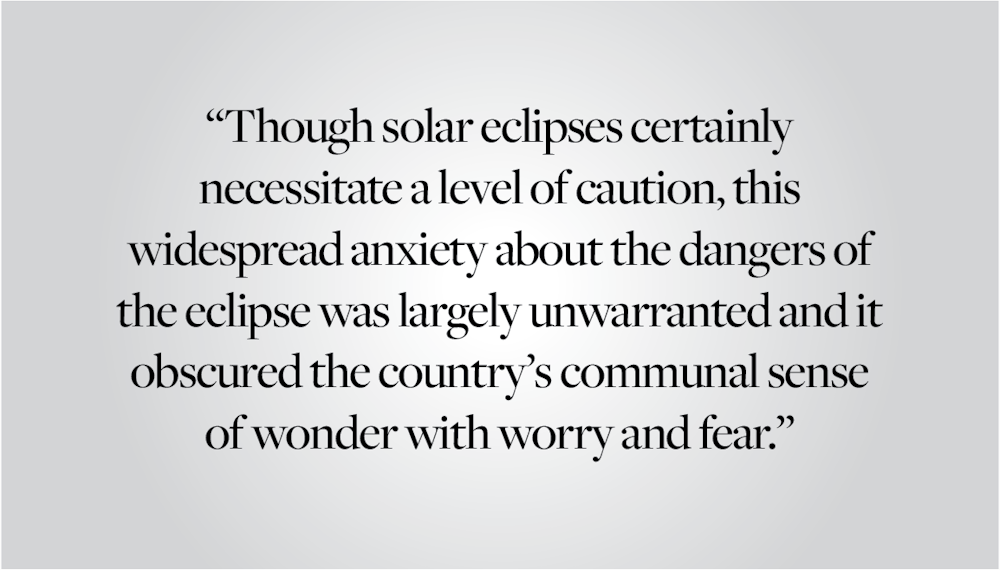The solar eclipse earlier this week sparked widespread wonder and amazement. The Main Green was filled with hundreds of students excited to view the first total American solar eclipse since 2017. This awe, however, was accompanied by serious warnings to not look at the sun during the eclipse without proper protective eyewear. News platforms published articles with eye-catching headlines like “Why you absolutely cannot stare at the sun without eclipse glasses.” Others published long lists about how to stay safe during the eclipse. Some schools closed early out of fear that students would stare at the sun during dismissal, while others canceled classes entirely.
Though solar eclipses certainly necessitate a level of caution, this widespread anxiety about the dangers of the eclipse was largely unwarranted and it obscured the country’s communal sense of wonder with worry and fear.
Staring at an eclipse without appropriate eye protection is obviously ill-advised. Such actions could lead to severe injury. For example, during the 2017 solar eclipse, one patient suffered permanent eye damage after directly looking at the sun for 20 seconds. However, most people intuitively know not to stare at the sun — it is always dangerous to do so, regardless of if an eclipse is occurring.
Still, despite these dangers, solar eclipses have never caused a significant number of eye injuries. During a 1991 eclipse that was watched by over 50 million people in Mexico, there were only 21 moderate cases of eclipse-related visual impairment recorded. A 1999 eclipse over the entirety of France resulted in 147 injuries. Similarly, the 2017 eclipse over North America was viewed by an estimated 150 million and still led to just 100 cases of retinal damage. Before this event, hospitals braced for a potential surge in patients. Some spent months preparing and planning. Yet, there was no notable increase in patients with eye problems. There was not even an uptick in other accidents typically associated with large national events. Furthermore, most of the people who came into hospitals with worries did not actually end up having substantial injuries.
One explanation for this lack of mass eye damage is that it is ultimately very difficult to permanently harm the human eye. Our eyes have evolved protective mechanisms that induce discomfort and trigger tearing when exposed to sunlight, which forces us to look away long before any lasting harm can occur. Incredibly, the eye can actually heal and protect itself: “Corneal abrasions” (colloquially known as eye scratches) heal without medical intervention, and tears prevent infections before they happen. Eyelids and eyelashes stop dirt, dust, and other foreign objects from entering the eye. This self-protection and healing is also true for eclipse-related concerns. In roughly half of instances where an eclipse causes blurry vision or the appearance of black spots, the issue resolves itself.
Though eclipse anxiety made it seem like anyone could face potential eye danger from the eclipse, many Americans likely did not even see it, and thus faced no danger. Many parts of the U.S. were covered with clouds, which made the eclipse hard to observe and less compelling for viewers. Plenty of others, I assume, were likely inside, busy with work or uninterested in the eclipse — only 53% of Americans expressed the intention to watch it. Plus, the eclipse was fairly brief — and thus easier to miss — in regions further from the “path of totality.” For instance, it was only visible for about an hour in Los Angeles (compared to nearly two-and-a-half hours in Providence).
Some of the concern over the eclipse may have just been human nature: we have a long-standing fear of uncontrollable solar events. (For example, the Babylonians thought that it could signify the imminent death of a king and the Incas suspected that it was a sign of their sun god Inti’s anger and coming wrath). Most of the worry, however, was a product of media alarmism and increasing safetyism. The reality is that few people look at the eclipse without eclipse glasses since looking directly at the sun is always uncomfortable. Even people who did look at it unprotected probably recovered. Furthermore, a large proportion of Americans likely missed the eclipse or did not care enough to watch it. As with previous solar eclipses, there was likely no surge in eye-related hospital visits. With all of that said, here is some way-too-early advice for the next American solar eclipse in 2044: don’t stare at the sun and enjoy the moment with your community. Your vision will be fine.
Ben Aizenberg can be reached at benjamin_aizenberg@brown.edu. Please send responses to this op-ed to letters@browndailyherald.com and other op-eds to opinions@browndailyherald.com





